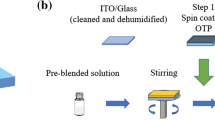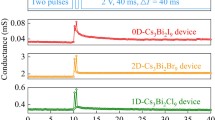Abstract
Recently, rapid progress has been made in the application of organic-inorganic halide perovskites in electronic devices, such as memristors and artificial synaptic devices. Organic-inorganic halide perovskite is considered as a promising candidate for the next generation of computing devices due to its ion migration property and advantages in manufacturing. In this work, a two-dimensional (2D)-3D organic-inorganic hybrid perovskite memristor was studied, using the stacking structure of indium tin oxide (ITO)/FA1−yMAyPbI3−xClx/(PEA)2PbI4/Au. The results show that this new type of memristor has novel resistance switching characteristics, such as scanning-rate-dependent current switching property, good current-voltage (I–V) curve repeatability, and ultralow energy consumption. A defect-modulated electron tunneling mechanism is demonstrated using the p-i-n junction model, and it is proven that the conductance state of the memristive device is determined by the defect concentration in the perovskite film near the electrode sides. In addition to the good memristive properties, this 2D-3D perovskite memristor can also function well as an artificial synapse, and its internal defect movement can faithfully simulate the inflow and extrusion of Ca2+ in biological synapses. Moreover, this perovskite-based artificial synapse has ultra-low power consumption due to the switchable p-i-n structure in organic-inorganic halide perovskites. Our finding highlights the immense application potential of the 2D-3D perovskite memristor in the future neuromorphic computing system.
摘要
近年来, 有机-无机卤化物钙钛矿在忆阻器和人工突触器件等电子器件中的应用取得了快速进展. 由于其离子迁移特性和制造上的优势, 有机-无机卤化物钙钛矿有望成为下一代计算设备的候选材料. 本文采用ITO/FA1−yMAyPbI3−xClx/(PEA)2PbI4/Au的叠层结构, 研究了2D-3D有机-无机杂化钙钛矿忆阻器. 结果表明, 这种新型忆阻器具有新颖的电阻开关特性, 如扫描速率相关的电流开关特性、良好的电流-电压曲线重复性和超低能耗. 利用p-i-n结模型证实了缺陷调制电子隧穿机制, 并证明了忆阻器件的电导状态由电极侧附近钙钛矿薄膜中的缺陷浓度决定. 除了良好的忆阻特性外, 这种2D-3D钙钛矿型忆阻器还可以很好地用作人工突触, 其内部缺陷运动可以真实地模拟生物突触中Ca2+的流入和挤出. 此外, 由于有机-无机卤化物钙钛矿中的可切换p-i-n结构, 这种基于钙钛矿的人工突触具有超低功耗. 我们的发现展示了2D-3D钙钛矿忆阻器在未来神经形态计算系统中的巨大应用潜力.

Similar content being viewed by others
References
Shi Z, Guo J, Chen Y, et al. Lead-free organic-inorganic hybrid perovskites for photovoltaic applications: Recent advances and perspectives. Adv Mater, 2017, 29: 1605005
Jeon NJ, Noh JH, Yang WS, et al. Compositional engineering of perovskite materials for high-performance solar cells. Nature, 2015, 517: 476–480
Miyata A, Mitioglu A, Plochocka P, et al. Direct measurement of the exciton binding energy and effective masses for charge carriers in organic-inorganic tri-halide perovskites. Nat Phys, 2015, 11: 582–587
Stoumpos CC, Kanatzidis MG. Halide perovskites: Poor man’s high-performance semiconductors. Adv Mater, 2016, 28: 5778–5793
Filip MR, Eperon GE, Snaith HJ, et al. Steric engineering of metal-halide perovskites with tunable optical band gaps. Nat Commun, 2014, 5: 5757
Walsh A, Stranks SD. Taking control of ion transport in halide perovskite solar cells. ACS Energy Lett, 2018, 3: 1983–1990
D’Innocenzo V, Srimath Kandada AR, De Bastiani M, et al. Tuning the light emission properties by band gap engineering in hybrid lead halide perovskite. J Am Chem Soc, 2014, 136: 17730–17733
Amat A, Mosconi E, Ronca E, et al. Cation-induced band-gap tuning in organohalide perovskites: Interplay of spin-orbit coupling and octahedra tilting. Nano Lett, 2014, 14: 3608–3616
Yin WJ, Shi T, Yan Y. Unusual defect physics in CH3NH3PbI3 perovskite solar cell absorber. Appl Phys Lett, 2014, 104: 063903
Bi C, Shao Y, Yuan Y, et al. Understanding the formation and evolution of interdiffusion grown organolead halide perovskite thin films by thermal annealing. J Mater Chem A, 2014, 2: 18508–18514
Yuan Y, Huang J. Ion migration in organometal trihalide perovskite and its impact on photovoltaic efficiency and stability. Acc Chem Res, 2016, 49: 286–293
Leguy AMA, Frost JM, McMahon AP, et al. The dynamics of methylammonium ions in hybrid organic-inorganic perovskite solar cells. Nat Commun, 2015, 6: 7124
Eames C, Frost JM, Barnes PRF, et al. Ionic transport in hybrid lead iodide perovskite solar cells. Nat Commun, 2015, 6: 7497
Docampo P, Ball JM, Darwich M, et al. Efficient organometal trihalide perovskite planar-heterojunction solar cells on flexible polymer substrates. Nat Commun, 2013, 4: 2761
You J, Hong Z, Yang YM, et al. Low-temperature solution-processed perovskite solar cells with high efficiency and flexibility. ACS Nano, 2014, 8: 1674–1680
Kim BJ, Kim DH, Lee YY, et al. Highly efficient and bending durable perovskite solar cells: Toward a wearable power source. Energy Environ Sci, 2015, 8: 916–921
Liu T, Chen K, Hu Q, et al. Inverted perovskite solar cells: Progresses and perspectives. Adv Energy Mater, 2016, 6: 1600457
Zhao Y, Zhu K. Organic-inorganic hybrid lead halide perovskites for optoelectronic and electronic applications. Chem Soc Rev, 2016, 45: 655–689
Meloni S, Moehl T, Tress W, et al. Ionic polarization-induced current-voltage hysteresis in CH3NH3PbX3 perovskite solar cells. Nat Commun, 2016, 7: 10334
Snaith HJ, Abate A, Ball JM, et al. Anomalous hysteresis in perovskite solar cells. J Phys Chem Lett, 2014, 5: 1511–1515
Wang Z, Lin Q, Chmiel FP, et al. Efficient ambient-air-stable solar cells with 2D–3D heterostructured butylammonium-caesium-formamidinium lead halide perovskites. Nat Energy, 2017, 2: 17135
Lin Y, Bai Y, Fang Y, et al. Enhanced thermal stability in perovskite solar cells by assembling 2D/3D stacking structures. J Phys Chem Lett, 2018, 9: 654–658
Stranks SD, Eperon GE, Grancini G, et al. Electron-hole diffusion lengths exceeding 1 micrometer in an organometal trihalide perovskite absorber. Science, 2013, 342: 341–344
Tress W, Marinova N, Moehl T, et al. Understanding the rate-dependent J-V hysteresis, slow time component, and aging in CH3NH3PbI3 perovskite solar cells: The role of a compensated electric field. Energy Environ Sci, 2015, 8: 995–1004
Xing G, Mathews N, Lim SS, et al. Low-temperature solution-processed wavelength-tunable perovskites for lasing. Nat Mater, 2014, 13: 476–480
Dualeh A, Moehl T, Tétreault N, et al. Impedance spectroscopic analysis of lead iodide perovskite-sensitized solid-state solar cells. ACS Nano, 2014, 8: 362–373
Fan Z, Xiao J, Sun K, et al. Ferroelectricity of CH3NH3PbI3 perovskite. J Phys Chem Lett, 2015, 6: 1155–1161
Brivio F, Walker AB, Walsh A. Structural and electronic properties of hybrid perovskites for high-efficiency thin-film photovoltaics from first-principles. APL Mater, 2013, 1: 042111
Walsh A, Scanlon DO, Chen S, et al. Self-regulation mechanism for charged point defects in hybrid halide perovskites. Angew Chem, 2015, 127: 1811–1814
Kim J, Lee SH, Lee JH, et al. The role of intrinsic defects in methylammonium lead iodide perovskite. J Phys Chem Lett, 2014, 5: 1312–1317
Yang JJ, Pickett MD, Li X, et al. Memristive switching mechanism for metal/oxide/metal nanodevices. Nat Nanotech, 2008, 3: 429–433
Xiao Z, Yuan Y, Shao Y, et al. Giant switchable photovoltaic effect in organometal trihalide perovskite devices. Nat Mater, 2015, 14: 193–198
Li Y, Zhong Y, Zhang J, et al. Activity-dependent synaptic plasticity of a chalcogenide electronic synapse for neuromorphic systems. Sci Rep, 2014, 4: 4906
Li Y, Zhong Y, Xu L, et al. Ultrafast synaptic events in a chalcogenide memristor. Sci Rep, 2013, 3: 1619
Abbott LF, Nelson SB. Synaptic plasticity: Taming the beast. Nat Neurosci, 2000, 3: 1178–1183
Shouval H. Spike timing dependent plasticity: A consequence of more fundamental learning rules. Front Comput Neurosci, 2010, 4: 19
Ohno T, Hasegawa T, Tsuruoka T, et al. Short-term plasticity and long-term potentiation mimicked in single inorganic synapses. Nat Mater, 2011, 10: 591–595
Waser R, Aono M. Nanoionics-based resistive switching memories. Nat Mater, 2007, 6: 833–840
Chanthbouala A, Garcia V, Cherifi RO, et al. A ferroelectric memristor. Nat Mater, 2012, 11: 860–864
Kuzum D, Jeyasingh RGD, Lee B, et al. Nanoelectronic programmable synapses based on phase change materials for brain-inspired computing. Nano Lett, 2012, 12: 2179–2186
Yuan Y, Chae J, Shao Y, et al. Photovoltaic switching mechanism in lateral structure hybrid perovskite solar cells. Adv Energy Mater, 2015, 5: 1500615
Acknowledgements
This work was financially supported by the National Natural Science Foundation of China (61674050, 62004056, and 61874158), the Project of Distinguished Young of Hebei Province (A2018201231), the Support Program for the Top Young Talents of Hebei Province (70280011807), the Hundred Persons Plan of Hebei Province (E2018050004 and E2018050003), the Supporting Plan for 100 Excellent Innovative Talents in Colleges and Universities of Hebei Province (SLRC2019018), the Special Project of Strategic Leading Science and Technology of Chinese Academy of Sciences (XDB44000000-7), the Special Support Funds for National High Level Talents (041500120001), Hebei Basic Research Special Key Project (F2021201045), the Science and Technology Project of Hebei Education Department (QN2020178 and QN2021026), and Singapore Ministry of Education (AcRF TIER 2-MOE2019-T2-2-075).
Author information
Authors and Affiliations
Contributions
Sun K, Wang Q, Zhou L performed the experiments. Sun K conducted the fitting and data analysis. Sun K and Guo R prepared the original manuscript. All the authors contributed to the general discussion, review and editing. Guo R, Yan X, and Tay BK contributed to the conceptualization and supervision.
Corresponding authors
Additional information
Conflict of interest
The authors declare that they have no conflict of interest.
Supplementary information
Supporting data are available in the online version of the paper.
Kaixuan Sun received his BSc degree in microelectronics science and engineering from the School of Physics and Optoelectronic Engineering, Xiangtan University, China in 2018, and ME degree in integrated circuit engineering from the College of Electronic and information Engineering at Hebei University. His current research interest is the field of memristor materials.
Beng Kang Tay is a pioneer in filtered catholic vacuum arc (FCVA) technology and has been working for many years in developing thin film materials especially in amorphous carbon, nanocomposites, graphene and carbon nanotubes. His current research interest includes the growth and application of 2D transition metal dichalcogenide materials and their heterostructures, the fabrication and characterization of nanostructures for field emission, thermal and high-frequency RF applications.
Xiaobing Yan is currently a professor at the College of Electronic and Information Engineering, Hebei University. He received his PhD degree from Nanjing University in 2011. From 2014 to 2016, he held a research fellowship at the National University of Singapore. His current research interest includes the study of novel flash memory, resistive memory, memristors and other novel electronic device integration and logic-controlled embedded circuit design for integration, and the study of memristor arrays for artificial neural networks.
Electronic Supplementary Material
Rights and permissions
About this article
Cite this article
Sun, K., Wang, Q., Zhou, L. et al. 2D-3D perovskite memristor with low energy consumption and high stability for neural morphology calculation. Sci. China Mater. 66, 2013–2022 (2023). https://doi.org/10.1007/s40843-022-2317-0
Received:
Accepted:
Published:
Issue Date:
DOI: https://doi.org/10.1007/s40843-022-2317-0




